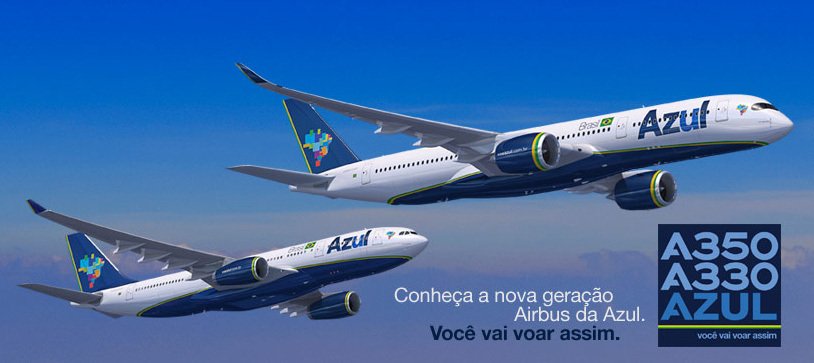Brazilian low-cost carrier Azul Linhas Aéreas Brasileiras has confirmed plans to acquire its first widebodied aircraft as it makes its anticipated growth into long-haul international markets. The carrier will add six Airbus A330-200s and five A350-900s to its fleet in the coming years to begin flights to the US from early 2015 and possibly into Europe from 2017.
The announcement marks a significant change for the carrier which currently serves the Brazilian domestic market with a fleet comprising only regional aircraft, namely the Embraer E-Jet family and ATR turboprop equipment. It could also change the dynamics of the Brazil – USA market as Azul will almost certainly build a partnership with US carrier JetBlue Airways, which was also founded by its chief executive officer, David Neeleman, establishing a significant network between the two markets.
The likely partnership with JetBlue is driving suggestions that Azul’s initial US network will comprise Fort Lauderdale and Orlando in Florida and New York, all markets where JetBlue has a notable presence. The carrier says it has yet to confirm its initial schedule but said a final decision will be made later this year.
“Our customers have been asking for this and now we look forward to providing them with our superior service on international flights, just as we have been doing today on our 880 daily domestic departures,” said David Neeleman, chief executive officer, Azul. “We’re excited to share the Azul experience with new customers internationally and expand the airline’s success story beyond Brazil’s borders.”
After less than six years of operations, Azul has already flown more than 85 million passengers and changed the face of air travel in the Brazilian market since its first flight, on December 15, 2008 and it hopes to replicate this success in international markets. In five and a half years of operations, it has expanded its schedule to offer 880 daily flights, which represents one-third of Brazil’s daily departures.
The majority of the eleven widebodies will be sourced from International Lease Finance Coporation (ILFC) and will enable earlier delivery slots than if they had been acquired directly from the manufacturer. The lessor will supply three A330-200s from the second half of this year and the five A350-900s in 2017. All will be powered by Rolls-Royce engines. The source of the three outstanding A330-200s has not yet been confirmed.

“ILFC is pleased to support Azul’s introduction of international service with these Airbus A350s and A330s,” said its chief executive officer, Henri Courpron. “There is a real opportunity for Azul to build on its successful base in Brazil and provide air service in a region which is becoming increasingly important to the aviation marketplace.”
There has been a significant increase in air services between Brazil and the US in recent years as a more relaxed bilateral agreement has been introduced ahead of the expected establishment of full Open Skies between the countries from October 1, 2015. This agreement between the two most populous countries and largest economies in the Americas has been a significant achievement after many years of negotiation.
Despite the size of the countries and their economies, passenger air service between Brazil and the US is relatively underdeveloped. Geography is partly to blame: Brazil’s major cities on the South Atlantic coast are a long way from the population centres of the US. However, the US-Brazil Open Skies Agreement is a vote of confidence in the South American country’s aviation sector and its international competitiveness.
This market has been dominated by American Airlines, which has only strengthened its position following the collapse of Brazil’s largest international carrier Varig. TAM Airlines, part of the LATAM Group is now the prominent carrier from the South American country but Sao Paulo-based Gol Linhas Aéreas Inteligentes also offers international flights, many flying via a scissor hub in Santo Domingo in the Dominican Republic due to its exclusive operation of single-aisle airliners.
Azul’s flights will operate from its base at Viracopos International Airport which serves the city of Campinas in São Paulo State. The facility is among the busiest in Brazil and acts as an alternative gateway into São Paulo alongside the larger Guarulhos International Airport and Congonhas Airport. According to latest statistics it is ranked as the eighth largest passenger and second largest cargo airport in the country, although direct international links are limited with a Gol link to Buenos Aires and TAP Portugal flight to Lisbon the only current regular scheduled services.
From July this year, Viracopos will gain its first regular link after Gol recently received the green light from the National Civil Aviation Agency (ANAC) and other pertinent authorities to operate flights to Miamivia Santo Domingo. Its international connections in the Dominican Republic will also permit a one-stop offering to Orlando. This three times weekly link is scheduled to begin from July 18, 2014.
In our analysis below we highlight which airlines have been the principal players in the market between the US and Brazil over the past ten years, based on annual one way seat capacity from Brazil to the US. Over this period capacity has grown by 127.1 per cent from 1.3 million seats in 2004 to 3.1 million last year. The chart shows each airlines market share during the period and shows the dominant role American Airlines has held in this market with a 34.1 per cent share of the total capacity from Brazil to the US since the start of 2000, that is almost seven million seats in each direction.





